Picking the right yarn for socks can be overwhelming. Many options include wool, cotton, blends, hand-dyed, and commercial.
Some are soft but wear out fast. Others last forever but feel rough on your feet. So, how do you choose?
I’ve been knitting socks for years. I’ve made mistakes, tested different fibers, and learned what works. In this guide, I’ll break it all down for you.
You’ll learn:
- What makes a good sock yarn (durability, stretch, and comfort)
- The best fibers for socks and when to use them
- How weight, ply, and color affect your project
I’ll keep it simple and honest. No fluff, just practical advice. By the end, you’ll know exactly what to look for. Let’s get started.
What Makes a Good Sock Yarn?
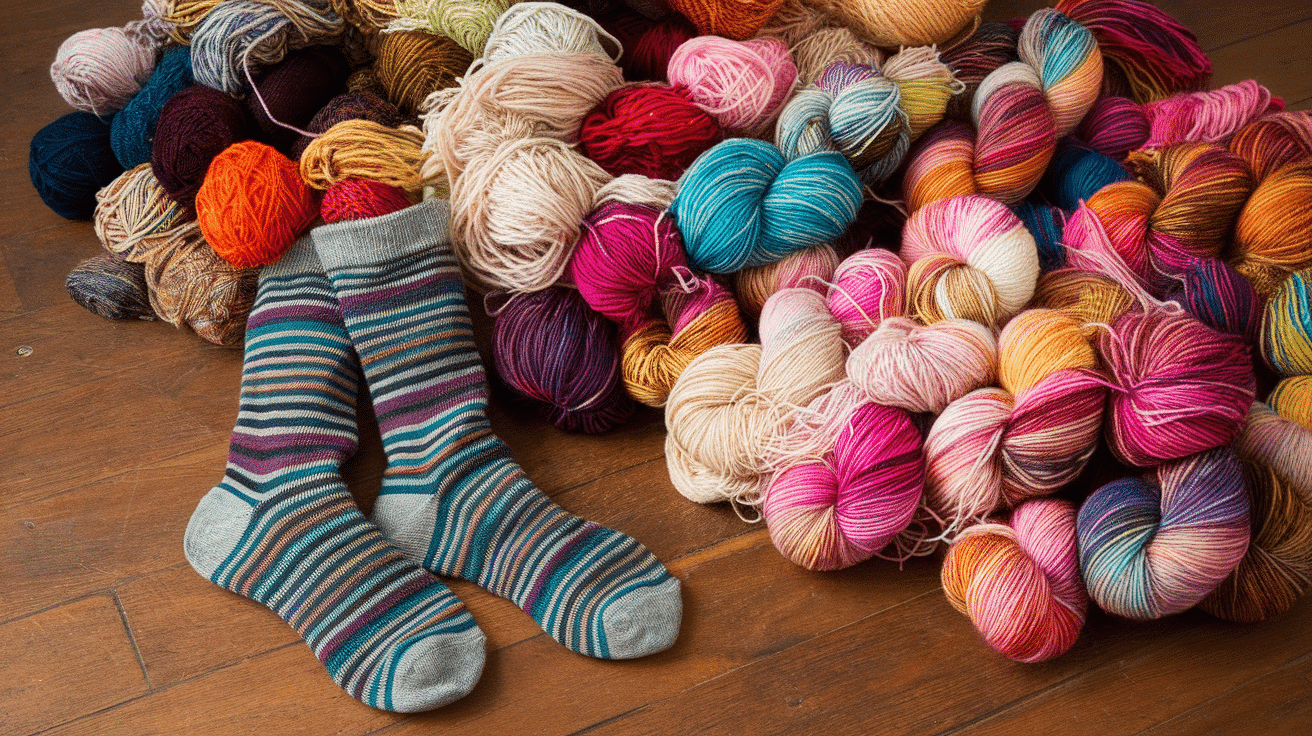
Not all yarns work for socks. Some stretch out too much. Others wear thin after a few washes. So, what should you look for? I focus on three things:
1. Durability
Think about it—your socks rub against shoes, floors, and each other. Weak yarn won’t last long. Look for:
- Wool with nylon – Nylon adds strength.
- Tightly spun yarn – Loose fibers wear out fast.
- Multiple plies – More plies mean more durability.
2. Stretch & Recovery
You don’t want socks that stretch out and slide down. The best yarn has:
- Elasticity – Wool naturally bounces back.
- A little nylon or spandex – Helps hold shape.
3. Breathability
Good socks should keep your feet warm, not sweaty. Choose:
- Wool– Absorbs moisture and keeps feet dry.
- Blends with natural fibers – Stay away from all synthetic yarns.
Get these three things right, and your socks will last longer, feel better, and stay in place.
Fiber Choices for Sock Yarn
Choosing the right fiber for sock yarn is essential for durability, comfort, and warmth. Different fibers offer varying levels of stretch, breathability, and moisture-wicking properties.
Let’s see find some of the best fiber choices for sock knitting:
1. Wool
If I had to pick one fiber, it would be wool. It’s warm, stretchy, and wicks moisture. Plus, it holds its shape. Look for:
- Superwash wool – Machine washable and easy to care for.
- Merino wool – Soft but may need nylon for strength.
2. Nylon Blends
Wool is great, but pure wool socks wear out fast. That’s where nylon helps.
- A little nylon (10-25%) adds durability.
- It also helps socks keep their shape.
- Most good sock yarns have wool and nylon mix.
3. Cotton
Cotton is soft and breathable, but it’s tricky.
Pros:
- It feels cool in warm weather.
- Absorbs moisture well.
Cons:
- No stretch – Socks can sag.
- Wears out faster – Needs a blend with elastic fibers.
4. Other Fibers
Some yarns look fancy but don’t last.
- Bamboo – Soft and breathable but stretches too much.
- Alpaca – Warm and soft but not durable alone.
- Silk – Adds shine but needs wool for strength.
For the best results, choose wool blends. They last longer, feel good, and won’t let you down.
Understanding Yarn Weight and Ply
Not all sock yarn is the same thickness. Some are light and delicate. Others are thick and sturdy. So, which one should you use?
Fingering Weight vs. DK – Which Works Best?
Most socks are made with fingering-weight yarn, which is thin, stretchy, and perfect for everyday wear. But DK-weight yarn also works. It’s thicker, cozier, and great for house socks or winter wear.
So, which one should you choose?
- Go with fingering weight for classic socks that fit in shoes.
- Choose DK weight for warm, quick-to-knit socks.
How does Ply affect durability and Feel?
Ply refers to how many strands are twisted together. More plies usually mean stronger yarn.
- Single-ply – Soft but weak. It’s not great for socks.
- Two-ply – A little better but still not the best.
- Three-ply or more – Strong, holds up to wear, and keeps its shape.
Balancing Softness and Strength
Softer yarns feel nice, but they wear out faster. Tougher yarns last longer but might feel scratchy at first. Here’s how to get the best of both:
- Look for wool blends with nylon.
- Choose a yarn with multiple plies.
- Wash and wear your socks—wool softens over time.
Find the right mix; your socks will last longer and feel great.
Color and Dye Considerations
Color is fun to choose, but it affects how your socks look over time. Some colors hide mistakes. Others show off fancy stitches. And not all dyes last.
Solid vs. Variegated – What Works Best?
Different colors work better for other patterns.
- Solid colors – Best for cables, lace, or textured stitches. They make patterns stand out.
- Variegated yarns – Fun and colorful but can hide stitch details. Great for simple designs.
If you want texture to pop, go solid. If you love color changes, go variegated.
Hand-Dyed vs. Commercial – Pros and Cons
Hand-dyed yarns look beautiful. Commercial yarns are more predictable.
Hand-dyed yarn:
- Unique and artistic
- Colors may pool in odd ways
- Slight variations between skeins
Commercial yarn:
- Consistent colors
- Usually colorfast and fade-resistant
- Often more affordable
Colorfastness – Avoid Bleeding and Fading
Nothing’s worse than socks that bleed dye in the wash.
Before knitting:
- Check for colorfast yarns
- Pre-rinse hand-dyed yarn.
After knitting:
- Wash in cold water. Heat can set stains on your feet or in the wash.
- Use wool-friendly detergent. Harsh soaps can strip color.
Choosing the right color and dye type ensures your socks stay vibrant and wash after wash.
Practical Tips for Sock Yarn Shopping
Buying sock yarn can be exciting, but it helps to know what to look for. How much do you need? Where should you buy it? What brands are worth it? Let’s break it down.
1. How Much Yarn Do You Need?
This depends on sock size and yarn weight.
- Fingering weight(most common) – 100g for an average pair
- DK weight – 150g for a thicker pair
- Larger feet or longer socks? Add 25-50g just in case
Always check the yardage. Some skeins are smaller than they look.
2. Best Brands & Budget-Friendly Options
Good sock yarn doesn’t have to be expensive.
Reliable brands:
- Opal – Durable, fun colors
- Regia – Long-lasting and machine washable
- Malabrigo Sock – Soft and hand-dyed
- Cascade Heritage – Affordable and strong
On a budget? Look for:
- House brands at local yarn shops
- Drops Fabel or Knit Picks Stroll
- Leftover yarn—mix colors for fun socks!
3. Where to Shop: Online vs. Local Stores
Local yarn stores:
- You can feel the yarn before buying
- Staff can help with choices
- Supports small businesses
Online shops:
- More variety, especially hand-dyed options
- Easy to compare prices
- Convenient, but you can’t check the softness
If possible, buy a skein in person first. Then, stock up online once you find a brand you love.
My Favorite Sock Yarns and Why
I’ve tried many sock yarns. Some wore out too quickly, and others felt amazing but were tricky to knit. Over time, I found a few that I keep coming back to.
1. Opal Sock Yarn
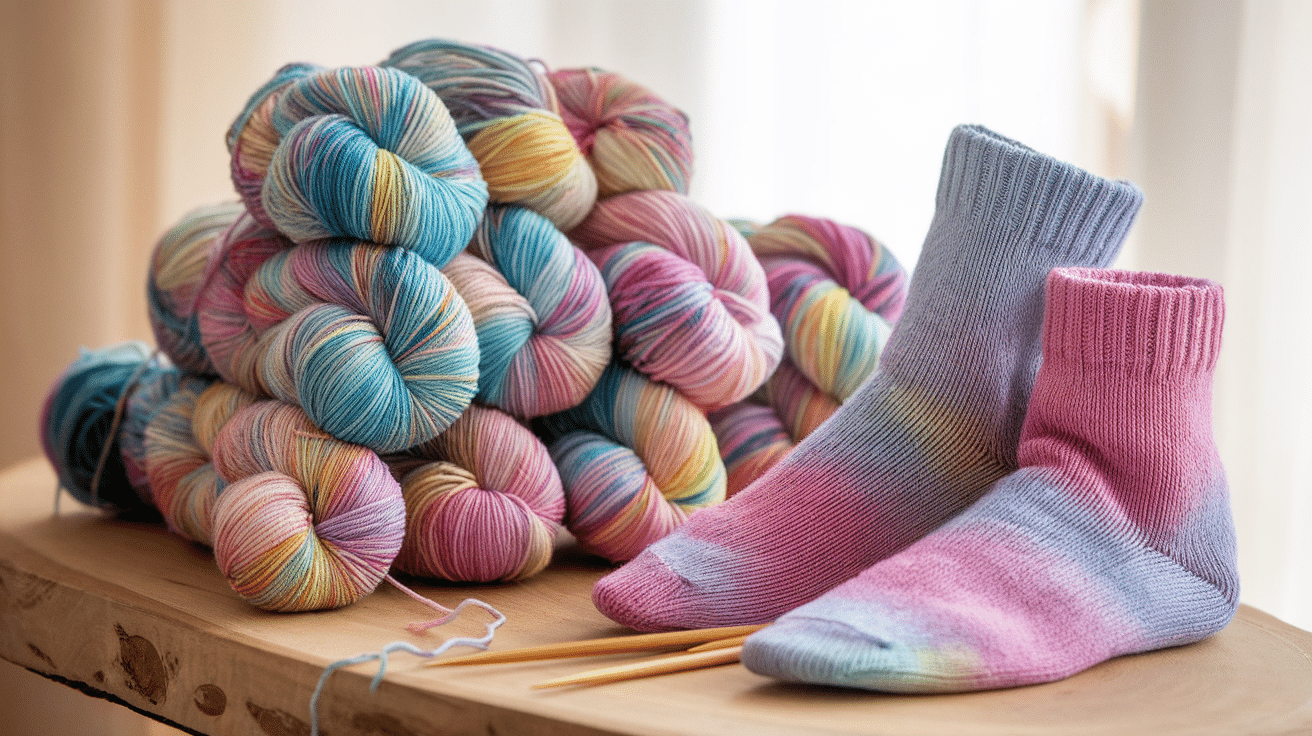
This is my go-to for everyday socks. It’s strong, colorful, and holds up well to washing. If you want socks that last, this is a great choice.
Unique features:
- 75% wool, 25% nylon for durability
- Machine washable
- Self-striping and fun patterns
If you want to see more, click here.
2. Malabrigo Sock
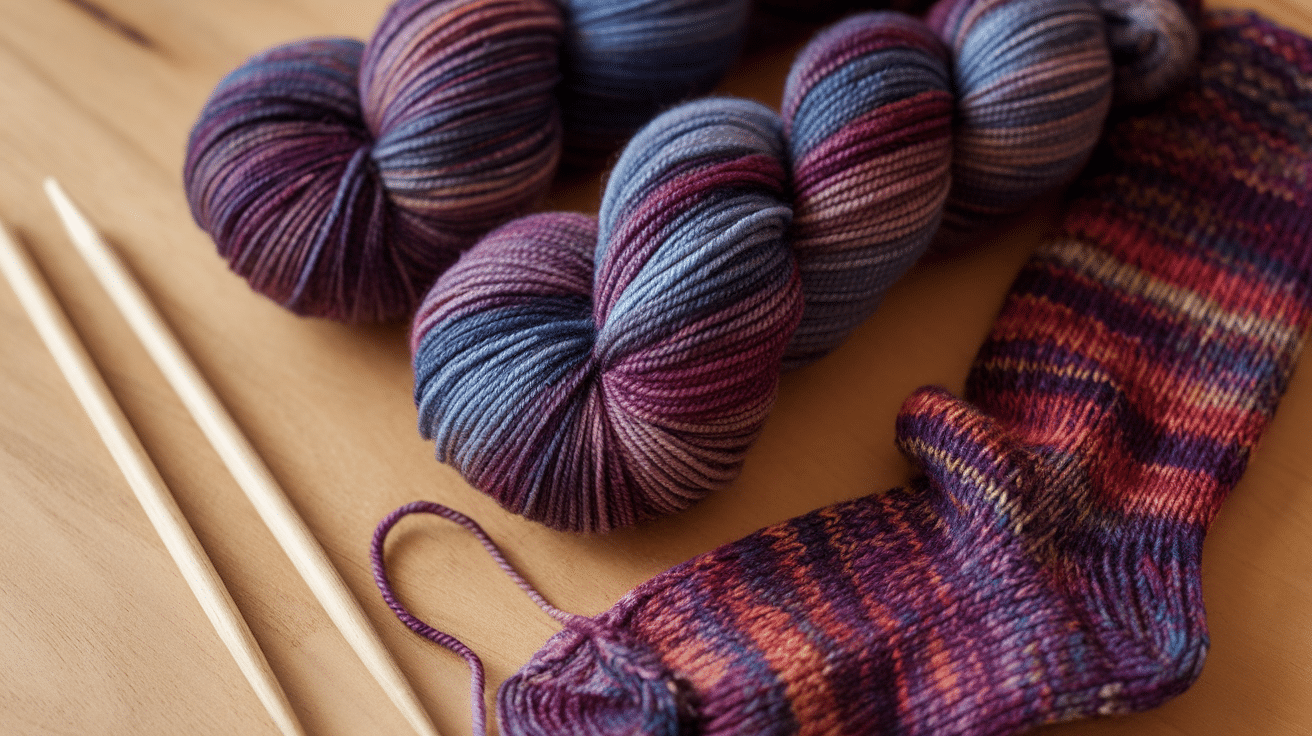
This soft and luxurious yarn feels amazing on your feet. Because it’s a bit more delicate, I save it for special socks or light wear.
Unique features:
- 100% merino wool – no nylon
- Hand-dyed with deep, rich colors
- It works great for shawls, too
If you’re curious to learn more, click here.
3. Regia 4-Ply
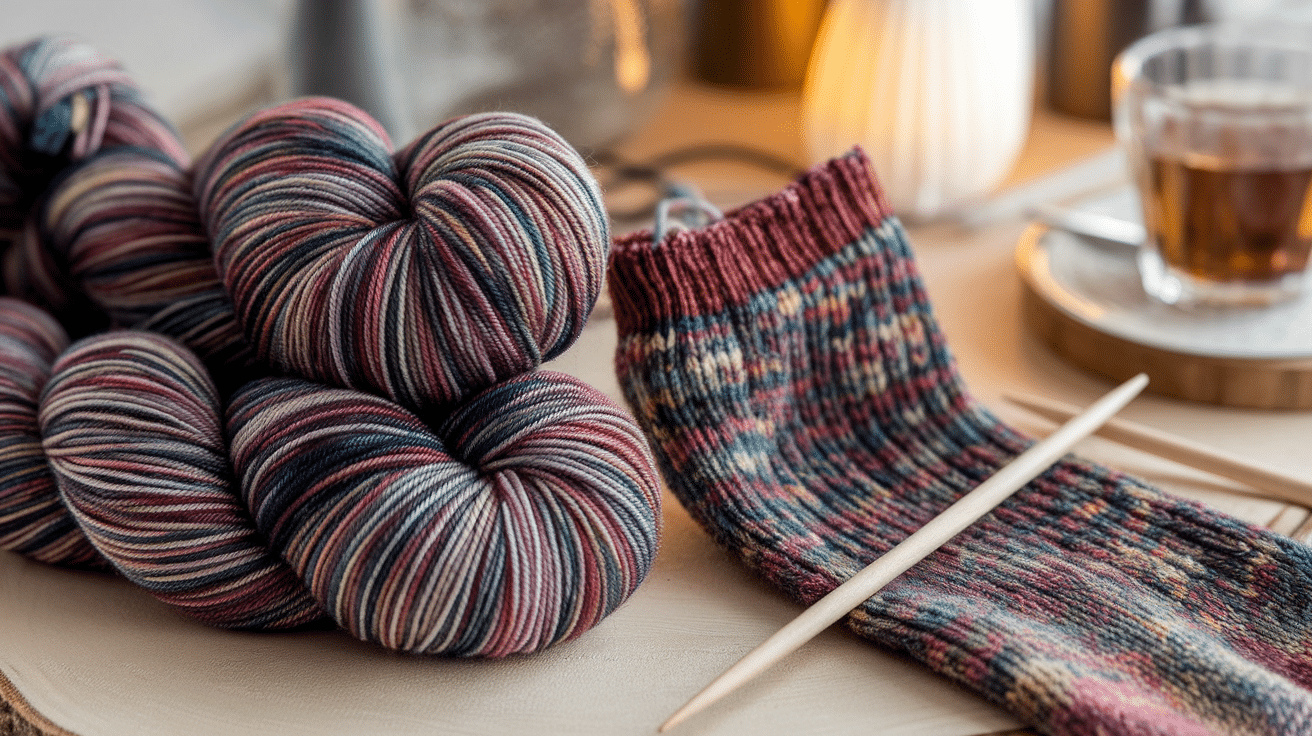
Regia is a solid choice for long-lasting socks. The yarn is smooth, easy to knit, and lasts for years.
Unique features:
- Reinforced with nylon for extra strength
- Comes with a 10-year guarantee
- Wide range of colors and patterns
If you’re eager to see more, click here.
4. Cascade Heritage

This is a great budget-friendly yarn that still feels nice to knit. It’s soft, strong, and easy to find.
Unique features:
- 75% superwash merino, 25% nylon
- It comes in solid and hand-painted colors
- Affordable without sacrificing quality
Want to take a closer look? Click here.
5. Knit Picks Stroll
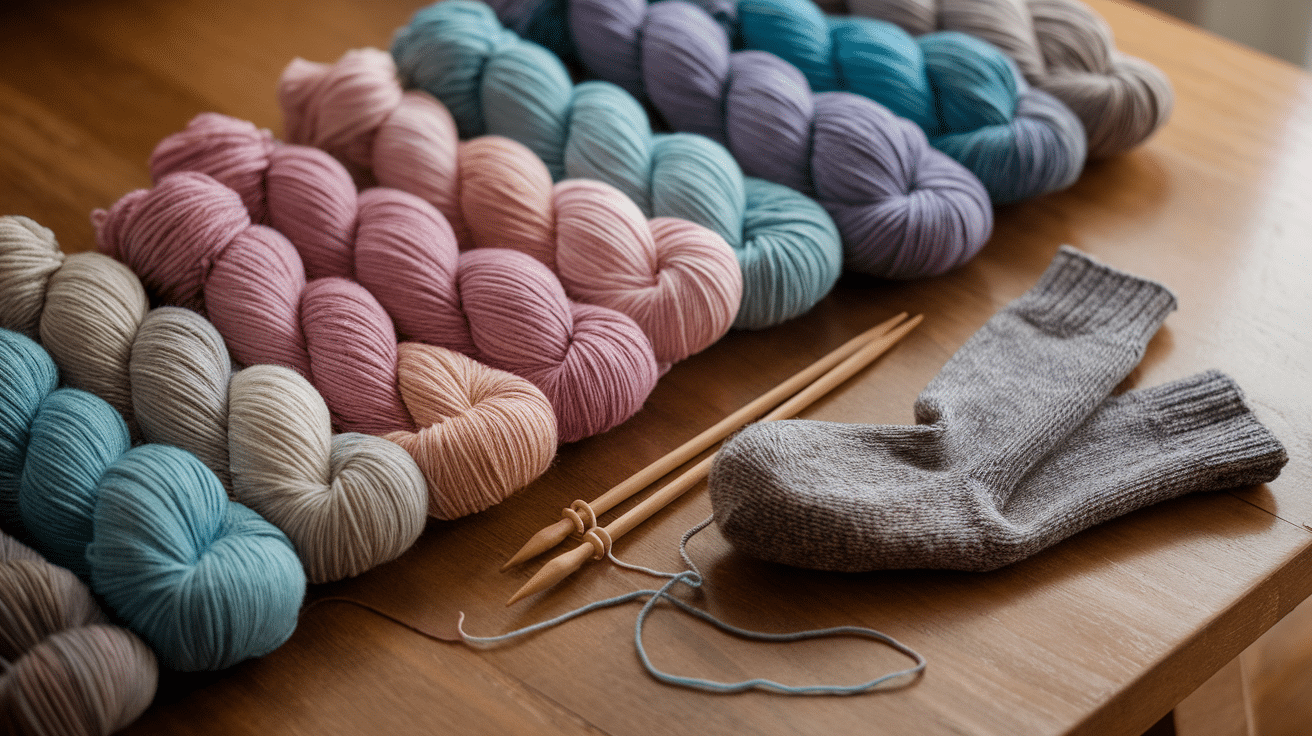
This is a great yarn if you’re starting with sock knitting. It’s soft, stretchy, and won’t break the bank.
Unique features:
- 75% superwash merino, 25% nylon
- Affordable and beginner-friendly
- It comes in solids, heathers, and hand-painted options
Curious to see what’s next? Click here.
These yarns have never let me down. No matter your budget or skill level, there’s something here for you.
Conclusion
Picking the right sock yarn makes a big difference. You want something durable, stretchy, and breathable.
Wool blends are usually the best choice, especially with a bit of nylon for strength. Fingering weight works for everyday socks, while DK is great for extra warmth.
There’s no single “perfect” yarn—just what works best for you. Try different fibers, brands, and colors. See what feels good on your needles and your feet.
Do you have a favorite sock yarn? I’d love to hear about it! Drop a comment and share your go-to picks.
Happy knitting, and may your socks be warm and long-lasting!
Frequently Asked Questions
What Is the Best Yarn for Socks?
Wool blends with nylon are ideal for socks. They offer durability, stretch, and comfort. Superwash merino or nylon blends are popular choices for lasting socks.
How Much Yarn Do I Need for Socks?
For fingering weight yarn, you’ll need about 100g per pair. And for DK weight, aim for 150g. Always check the yardage on the label.
Can I Use Cotton Yarn for Socks?
Cotton yarn can be used but may not provide enough stretch. It’s better for warm-weather socks but can wear out faster without a nylon or wool blend.









